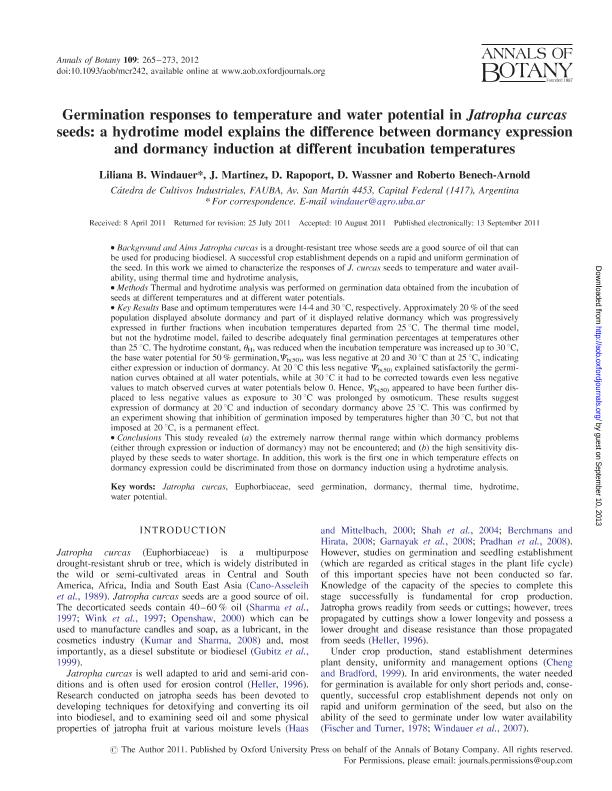Mostrar el registro sencillo del ítem
dc.contributor.author
Windauer, Liliana

dc.contributor.author
Martinez, J.
dc.contributor.author
Rapoport, D.
dc.contributor.author
Wassner, Diego Fernan

dc.contributor.author
Benech-Arnold, Roberto Luis

dc.date.available
2020-02-14T20:41:27Z
dc.date.issued
2012-01
dc.identifier.citation
Windauer, Liliana; Martinez, J.; Rapoport, D.; Wassner, Diego Fernan; Benech-Arnold, Roberto Luis; Germination responses to temperature and water potential in Jatropha curcas seeds: A hydrotime model explains the difference between dormancy expression and dormancy induction at different incubation temperatures; Oxford University Press; Annals of Botany; 109; 1; 1-2012; 265-273
dc.identifier.issn
0305-7364
dc.identifier.uri
http://hdl.handle.net/11336/97676
dc.description.abstract
•Background and Aims: Jatropha curcas is a drought-resistant tree whose seeds are a good source of oil that can be used for producing biodiesel. A successful crop establishment depends on a rapid and uniform germination of the seed. In this work we aimed to characterize the responses of J. curcas seeds to temperature and water availability, using thermal time and hydrotime analysis,•Methods: Thermal and hydrotime analysis was performed on germination data obtained from the incubation of seeds at different temperatures and at different water potentials.•Key Results: Base and optimum temperatures were 14·4 and 30 °C, respectively. Approximately 20 of the seed population displayed absolute dormancy and part of it displayed relative dormancy which was progressively expressed in further fractions when incubation temperatures departed from 25 °C. The thermal time model, but not the hydrotime model, failed to describe adequately final germination percentages at temperatures other than 25 °C. The hydrotime constant, θH, was reduced when the incubation temperature was increased up to 30 °C, the base water potential for 50 germination,Ψ b(50), was less negative at 20 and 30 °C than at 25 °C, indicating either expression or induction of dormancy. At 20 °C this less negative Ψ b(50) explained satisfactorily the germination curves obtained at all water potentials, while at 30 °C it had to be corrected towards even less negative values to match observed curves at water potentials below 0. Hence, Ψ b(50) appeared to have been further displaced to less negative values as exposure to 30 °C was prolonged by osmoticum. These results suggest expression of dormancy at 20 °C and induction of secondary dormancy above 25 °C. This was confirmed by an experiment showing that inhibition of germination imposed by temperatures higher than 30 °C, but not that imposed at 20 °C, is a permanent effect.•Conclusions: This study revealed (a) the extremely narrow thermal range within which dormancy problems (either through expression or induction of dormancy) may not be encountered; and (b) the high sensitivity displayed by these seeds to water shortage. In addition, this work is the first one in which temperature effects on dormancy expression could be discriminated from those on dormancy induction using a hydrotime analysis.
dc.format
application/pdf
dc.language.iso
eng
dc.publisher
Oxford University Press

dc.rights
info:eu-repo/semantics/openAccess
dc.rights.uri
https://creativecommons.org/licenses/by-nc-sa/2.5/ar/
dc.subject
DORMANCY
dc.subject
EUPHORBIACEAE
dc.subject
HYDROTIME
dc.subject
JATROPHA CURCAS
dc.subject
SEED GERMINATION
dc.subject
THERMAL TIME
dc.subject
WATER POTENTIAL
dc.subject.classification
Agricultura

dc.subject.classification
Agricultura, Silvicultura y Pesca

dc.subject.classification
CIENCIAS AGRÍCOLAS

dc.title
Germination responses to temperature and water potential in Jatropha curcas seeds: A hydrotime model explains the difference between dormancy expression and dormancy induction at different incubation temperatures
dc.type
info:eu-repo/semantics/article
dc.type
info:ar-repo/semantics/artículo
dc.type
info:eu-repo/semantics/publishedVersion
dc.date.updated
2020-02-07T13:39:04Z
dc.journal.volume
109
dc.journal.number
1
dc.journal.pagination
265-273
dc.journal.pais
Reino Unido

dc.journal.ciudad
Oxford
dc.description.fil
Fil: Windauer, Liliana. Universidad de Buenos Aires. Facultad de Agronomía. Departamento de Producción Vegetal. Cátedra de Cultivos Industriales; Argentina. Consejo Nacional de Investigaciones Científicas y Técnicas; Argentina
dc.description.fil
Fil: Martinez, J.. Universidad de Buenos Aires. Facultad de Agronomía. Departamento de Producción Vegetal. Cátedra de Cultivos Industriales; Argentina
dc.description.fil
Fil: Rapoport, D.. Universidad de Buenos Aires. Facultad de Agronomía. Departamento de Producción Vegetal. Cátedra de Cultivos Industriales; Argentina
dc.description.fil
Fil: Wassner, Diego Fernan. Universidad de Buenos Aires. Facultad de Agronomía. Departamento de Producción Vegetal. Cátedra de Cultivos Industriales; Argentina. Consejo Nacional de Investigaciones Científicas y Técnicas; Argentina
dc.description.fil
Fil: Benech-Arnold, Roberto Luis. Universidad de Buenos Aires. Facultad de Agronomía. Departamento de Producción Vegetal. Cátedra de Cultivos Industriales; Argentina. Consejo Nacional de Investigaciones Científicas y Técnicas; Argentina
dc.journal.title
Annals of Botany

dc.relation.alternativeid
info:eu-repo/semantics/altIdentifier/doi/http://dx.doi.org/10.1093/aob/mcr242
dc.relation.alternativeid
info:eu-repo/semantics/altIdentifier/url/https://academic.oup.com/aob/article/109/1/265/151957
Archivos asociados
